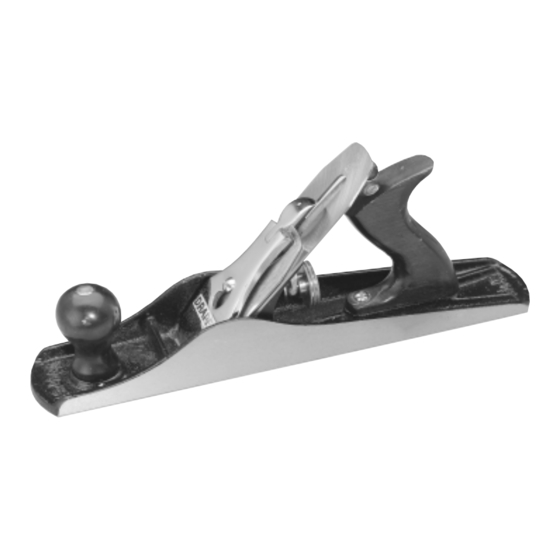
Subscribe to Our Youtube Channel
Summary of Contents for Draper P5
- Page 1 SMOOTHING PLANE STOCK No.57590 PART No.P5 • INSTRUCTIONS • IMPORTANT: PLEASE READ THESE INSTRUCTIONS CAREFULLY TO ENSURE THE SAFE AND EFFECTIVE USE OF THIS TOOL. 05/99...
- Page 2 COMPONENTS Fig.1...
- Page 3 5˚ to honing angle of 30˚ (Fig.4). (b) Hone the bevel along the stone, until a burr is formed on the back of the iron. For easy honing of plane irons use Draper HG1 honing guide Stock No.12400.
- Page 4 (c) Lay iron flat on the oil stone Fig.5 with bevel upwards (Fig.5). A few light strokes along the stone will remove the burr. The shape of the honed edge Fig.6 Fig.7 depends on the final use to which the plane is to be put. Straight with round corners for finishing work (Fig.6) and curved for coarse stock...
- Page 5 PREPARING THE PLANE The size of the mouth opening (Fig.9) Fig.9 depends on the use to which the plane will be put. Fine cabinet work requires a small mouth; general purpose work requires a larger mouth, (as factory setting). * Remove lever and double iron. * Slacken frog clamping screws.
- Page 6 TIPS AND MAINTENANCE * To improve iron performance, it is Fig.12 recommended that the procedure described in the ‘iron sharpening’ section (C) is used to “back-off” or polish the flat surface of the iron prior to honing. * After removing the burr, see ‘iron sharpening’...
- Page 7 2. PROBLEM: Fig.14 “Chatter” marks on work surface (Fig.14). REMEDY: Check frog clamping screws. Check lever cap pressure on iron. Check seating of iron on frog face. 3. PROBLEM: “Tram” lines or scoring marks on Fig.15 work surface (Fig.15). REMEDY: corners of iron too sharp should be honed to a radius.
- Page 8 ©Published by Draper Tools Ltd. No part of this publication may be reproduced, stored in a retrieval system or transmitted in any form or by any means, electronic, mechanical photocopying, recording or otherwise without prior permission in writing from Draper Tools Ltd.















Need help?
Do you have a question about the P5 and is the answer not in the manual?
Questions and answers